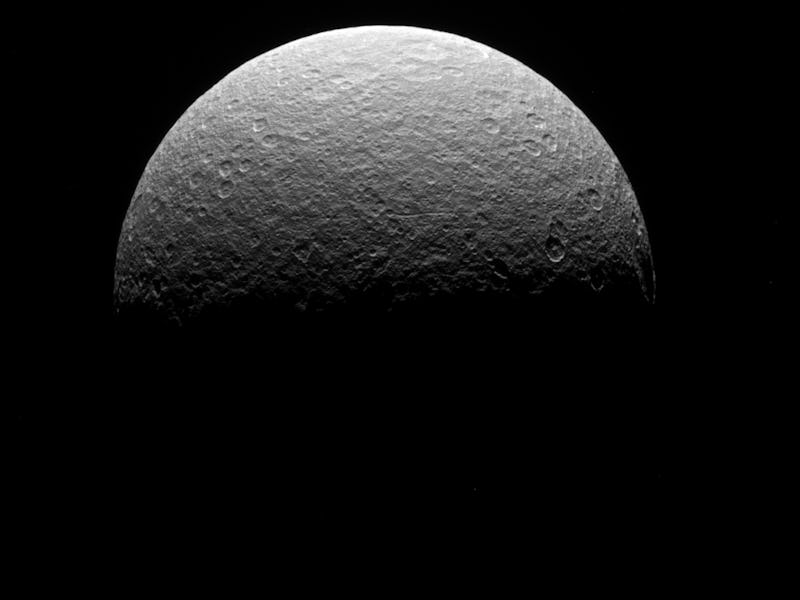Saturn's moon Rhea has a mysterious material on its surface

A new study reveals a curious relationship between Saturn's moon Rhea and its neighbor, Titan.
The second largest planet of the Solar System, Saturn is adorned by icy rings and orbited by a veritable swarm of some 80 moons.
These satellites have their own unique properties, some so unusual and intriguing that they stand out from other lunar bodies found throughout the Solar System, including our own natural companion, the Moon.
One of these strange celestial bodies is Saturn's second largest moon, Rhea. The moon may be a cold, airless object, but it also possesses three narrow, dense rings — a mirror of its host planet. These rings are the first ever discovered around a moon. Rhea's unique features do not end there, however — previous spectroscopy studies had hinted at an unidentifiable substance on the moon's surface.
And now, old Cassini data may resolve this longstanding lunar mystery.
The new findings are detailed in a study published Friday in the journal Science Advances.
Here's the background — Rhea is the second largest moon in orbit around Saturn — with a radius spanning 475 miles. The moon is tidally locked around Saturn, meaning that one side of Rhea constantly faces the large planet. It completes an entire orbit of the gas giant in 4.5 Earth days.
Rhea is a cold, harsh world. Its temperatures range from -281 degrees Fahrenheit on sunlit areas, to -364 degrees Fahrenheit on its dark side. In keeping with the cool temperatures, the moon is largely made up of water ice.
The mystery of Rhea's surface began decades ago, when NASA's Cassini spacecraft flew by Rhea as part of its mission to explore Saturn and its moons. Cassini performed a spectrographic analysis, collecting ultraviolet imaging data of the moon and its chemical make-up, confirming that its surface was made up of ice. But the data also showed evidence of an unidentifiable material.
A 3D model of Saturn's moon, Rhea, made by the NASA Visualization Technology Applications and Development.
How they did it — Bhalamurugan Sivaraman is an associate professor at the Physical Research Laboratory in India and co-author of the new study. He tells Inverse his team sought to investigate the chemical nature of this mysterious signal. To do that, the team turned back to the original Cassini data.
"We used data from the Cassini archive in order to understand exactly what's going on," Sivaraman says.
The team reanalyzed the data collected by one of Cassini's Rhea flybys, and ran experiments here on Earth to see if they could identify the chemical make-up of the molecules which produced the unknown absorption band.
The team behind the new study analyzed the data collected by Cassini's Rhea flyby, and ran lab experiments to test out different molecules and see which one would have produced the unknown signal.
Cassini detected an unidentifiable wavelength coming from Rhea, which scientists could not previously explain.
What they found — By running through possible candidates, the researchers eventually hit on the likely culprit: Hydrazine. This is the first time the compound has ever been detected on a moon, according to the study.
"When we did the experiment for hydrazine, it was a match," Sivaraman says.
Hydrazine is an inorganic compound, a colorless liquid with the same pungent smell as ammonia. Here on Earth, it is used in pharmaceuticals, agrochemicals, and as a propellant for spacecraft.
To understand where the hydrazine could've come from, Sivaraman and his colleagues essentially tried to recreate Rhea's surface conditions in the lab.
Curiously, these simulations suggest Rhea's lunar neighbor, Titan, Saturn's largest moon, may be have to do with the presence of hydrazine. Titan may be emitting nitrogen molecules towards Rhea, which would then interact with the radiation on the moon to convert nitrogen into hydrazine, the researchers suggest.
This kind of interaction between two moons is a rarity in our Solar System. But considering how large Titan is, it is likely the moon would exert some influence over its surrounding objects, Sivaraman explains.
What's next — Considering this is the first detection of hydrazine on a moon, the team behind the study want to further observe other moons to see if hydrazine forms anywhere else in the Solar System. They also suspect there may be more as-yet unknown chemistry waiting to be discovered, too.
"This particular work helps us identify another molecule, which we didn’t know existed before," Sivaraman says.
"We would like to look for molecules that are being absorbed in other wavelengths as well."
Abstract: We present the first analysis of far-ultraviolet reflectance spectra of regions on Rhea’s leading and trailing hemispheres collected by the Cassini Ultraviolet Imaging Spectrograph during targeted flybys. In particular, we aim to explain the unidentified broad absorption feature centred near 184 nm. We have used laboratory measurements of the UV spectroscopy of a set of candidate molecules and found a good fit to Rhea’s spectra with both hydrazine monohydrate and several chlorine-containing molecules. Given the radiation-dominated chemistry on the surface of icy satellites embedded within their planets’ magnetospheres, hydrazine monohydrate is argued to be the most plausible candidate for explaining the absorption feature at 184 nm. Hydrazine was also used as a propellant in Cassini’s thrusters, but the thrusters were not used during icy satellite flybys and thus the signal is believed to not arise from spacecraft fuel. We discuss how hydrazine monohydrate may be chemically produced on icy surfaces.
This article was originally published on